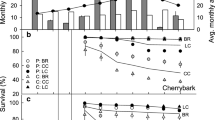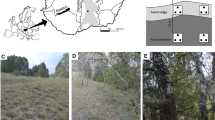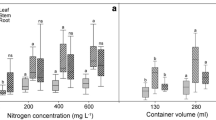Abstract
Regenerating oaks (Quercus L.) on mesic and hydric sites has remained a problem largely because of inadequate density and poor distribution of large oak advance reproduction prior to harvesting. We examined the effect of midstory and understory removal on the establishment and 3-year development of natural and artificial sources of pin oak (Q. palustris Muenchh.) advance reproduction in bottomland forests in southeastern Missouri, USA. Midstory and understory removals increased the photosynthetically-active radiation (PAR) reaching the seedling layer from about 3 to 15%. This increased light did not increase the density of natural pin oak advance reproduction compared to control, but it increased the survival and nominally increased the growth of the natural pin oak advance reproduction. Where the midstory and understory had been removed, underplanted RPM® container stock and bareroot pin oak stock maintained high survival, but of the two only the RPM® stock maintained positive height and diameter growth while bareroot stock suffered some growth reductions. Pin oaks originating from the direct seeding of stratified acorns sown in the spring had low germination and survival, but the survivors had growth rates similar to those of natural seedlings in thinned stands. Applying triclopyr to competitors in the ground flora layer only nominally increased PAR but reduced the percent survival and marginally increased the growth of natural and artificial pin oak. We conclude that artificial reproduction may be used to further increase the probability of achieving adequate numbers of the desired species in the future. Bareroot seedlings may not perform as well as RPM® seedlings and natural seedlings already present. However, bareroot and RPM® seedlings remained significantly larger than the natural seedlings after 3 years.




Similar content being viewed by others

References
Abrams MD (1998) The red maple paradox. BioScience 48:355–364. doi:10.2307/1313374
Allen JA, Keeland BD, Stanturf JA, Clewell AF, Kennedy HE Jr (2004) A guide to bottomland hardwood restoration. USDA For. Serv. Gen. Tech. Rep. SRS-40, 132 p
Ashton PMS, Berlyn GP (1994) A comparison of leaf physiology and anatomy of quercus (section Erythrobalanus-Fagaceae) species in different light environments. Am J Bot 81:589–597. doi:10.2307/2445734
Belli KL, Hart CP, Hodges JD, Stanturf JA (1999) Assessment of the regeneration potential of red oaks and ash on minor bottoms of Mississippi. South J Appl For 23:133–138
Bey CF (1990) Ulmus americana L. American elm. In: Burns RM, Honkala BH (Tech Coord) Silvics of Northern America, vol 2, Hardwoods. USDA For Serv Agric Handb 654, pp 801–807
Butler RE (1985) Soil survey of Stoddard County, Missouri. USDA Soil Conserv Serv 148 p
Clatterbuck WK, Meadows JS (1993) Regenerating oaks in bottomlands. In: Proceedings oak regeneration: serious problems, practical recommendations. USDA For Serv Gen Tech Rep, SE-84, pp 184–195
Collins B, Battaglia LL (2008) Oak regeneration in southeastern bottomland hardwood forest. For Ecol Manag 255:3026–3034
Dey DC, Parker WC (1997) Overstory density affects field performance of underplanted red oak (Quercus rubra L.) in Ontario. North J Appl For 4:120–125
Dey DC, Lovelace W, Kabrick JM, Gold MA (2004) Production and early field performance of RPM® seedlings in Missouri floodplains. Proceedings of the 6th walnut council research symposium. USDA For Serv Gen Tech Rep, NC-243, pp 59–65
Dey DC, Jacobs DF, McNabb K, Miller GW, Baldwin VC, Foster GS, Bridgwater F (2008) Artificial regeneration of major oak (Quercus) species in the eastern United States—a review of the literature. For Sci 54(1):77–106
Gardiner ES, Helmig LM (1997) Development of water oak stump sprouts under a partial overstory. New For 14:55–62. doi:10.1023/A:1006502107495
Gardiner ES, Hodges JD (1998) Growth and biomass distribution of cherrybark oak (Quercus pagoda Raf.) seedlings as influenced by light availability. For Ecol Manag 108:127–134
Gardiner ES, Yeiser JL (2006) Underplanting cherrybark oak (Quercus pagoda Raf.) seedlings on a bottomland site in the southern United States. New For 32:105–119. doi:10.1007/s11056-005-4168-2
Gottschalk KW (1994) Shade, leaf growth and crown development of Quercus rubra, Quercus velutina, Prunus serotina, and Acer rubrum seedlings. Tree Physiol 14:735–749
Hodges JD, Gardiner ES (1993) Ecology and physiology of oak regeneration. In: Proceedings oak regeneration: serious problems, practical recommendations. UDFS For Serv Gen Tech Rep, SE-84, pp 54–65
Hodges JD, Janzen G (1987) Studies on the biology of cherrybark oak: recommendations for regeneration. Proceedings of the 4th biennial southern silvicultural research conference. USDA For Serv Gen Tech Rep, SE-42, pp 133–139
Janzen GC, Hodges JD (1985) Influence of midstory and understory vegetation removal on the establishment and development of oak regeneration. Proceedings of the 3rd biennial southern silvicultural research conference. USDA For Serv Gen Tech Rep, SO-54, pp 273–278
Janzen GC, Hodges JD (1987) Development of advanced oak regeneration as influenced by removal of midstory and understory vegetation. Proceedings of the 4th biennial southern silvicultural research conference. USDA For Serv Gen Tech Rep, SE-42, pp 455–461
Jenkins MW, Chambers JL (1989) Understory light levels in mature hardwood stands after partial overstory removal. For Ecol Manag 26:247–256
Johnson RL (1980) New ideas about regeneration of hardwoods. P. 17–19. In: Proceedings of the hardwood committee’s symposium on oak regeneration
Johnson RL (1981) Oak seeding—it can work. South J Appl For 5:28–33
Johnson PS (1984) Responses of planted northern red oak to three overstory treatments. Can J Res 14:536–542. doi:10.1139/x84-099
Johnson RL, Krinard RM (1985) Regeneration of oaks by direct seedings. In: Proceedings of the 3rd symposium of southeastern Hardwoods. USDA For Serv, Southern Region, pp 56–65
Johnson PS, Shifley SR, Rogers R (2002) The ecology and silviculture of oaks. CABI Publishing, New York, p 503
Kennedy HE Jr (1990) Fraxinus pennsylvanica Marsh. Green ash. In: Burns RM, Honkala BH (Tech Coord) Silvics of Northern America, vol 2, Hardwoods. USDA For Serv Agric Handb 654, pp 348–354
Keys J Jr, Carpenter C, Hooks S, Koenig F, McNab WH, Russell W, Smith ML (1995) Ecological units of the eastern United States—1st approximation (map and booklet of map unit tables, Atlanta, GA. USDA For Serv, p 83
King SL, Grant WE (1996) A simulation model of the impacts of green-tree reservoir management on bottomland hardwood seedling growth and survival. Ecol Model 87:69–82
Kochenderfer JD, Zedaker SM, Johnson JE, Smith DW, Miller GW (2001) Herbicide hardwood crop tree release in central West Virginia. North J Appl For 18:45–54
Kolb TE, Steiner KC (1990) Growth and biomass partitioning of northern red oak and yellow-poplar seedlings: effects of shading and grass root competition. For Sci 36:34–44
Kormanik PP, Sung S-J S, Kormanik TL, Zarnock SJ (1995) Oak regeneration—why big is better. Proceedings of the forest and conservation nursery associations. USDA Gen Tech Rep, PNW-365, pp 117–123
Krekeler N, Kabrick JM, Dey DC, Wallendorf M (2006) Comparing natural and artificial methods for establishing pin oak advance reproduction in bottomland forests managed as greentree reservoirs. Proceedings of the 13th biennial southern silvicultural research conference. USDA For Serv Gen Tech Rep, SRS-92, pp 224–228
Lemmon PE (1956) A spherical densiometer for estimating forest overstory density. For Sci 2:314–320
Lhotka JM, Loewenstein EF (2008) Influence of canopy structure on the survival and growth of underplanted seedlings. New For 35:89–104
Lhotka JM, Zaczek JJ (2003) Soil scarification effects on oak reproduction in two mixed-oak bottomland stands of southern Illinois. South J Appl For 27:164–171
Lockhart BR, Hodges JD, Gardiner ES (2000) Response of advance cherrybark oak reproduction to midstory removal and shoot clipping. South J Appl For 24:45–50
Loftis DL (1990a) Predicting post-harvest performance of advance red oak reproduction in the southern Appalachians. For Sci 36:908–916
Loftis DL (1990b) A shelterwood method for regenerating red oak in the southern Appalachians. For Sci 36:917–929
Lorimer CG, Chapman JW, Lambert WD (1994) Tall understory vegetation as a factor in the poor development of oak seedlings beneath mature stands. J Ecol 82:227–237
Meadows JS, Stanturf JA (1997) Silvicultural systems for southern bottomland hardwood forests. For Ecol Manag 90:127–140
Merz RW, Brakhage GK (1964) The management of pin oak in a duck shooting area. J Wildl Manage 28:233–239
Messier C, Puttonen P (1995) Spatial and temporal variation in light environment of developing scots pine stands; the basis for a quick and efficient method of characterizing light. Can J For Res 25:343–354
Miller GW, Kochenderfer JN, Gottschalk KW (2004) Effect of pre-harvest shade control and fencing on northern red oak seedling development in the central Appalachians. In Spetich MA (ed) Proceedings of the upland oak ecology symposium: history, current conditions, and sustainability. USDA For Serv Gen Tech Rep, SRS-73, pp 182–189
Nelson JL, Ruffner CM, Groninger JW, Souter RA (2008) Drainage and agriculture impacts on fire frequency in a southern Illinois forested bottomland. Can J For Res 38:2932–2941
Nigh TA, Schroeder WA (2002) Atlas of Missouri ecoregions. Jefferson City, Missouri Department of Conservation, p 212
Nix LE, Cox SK (1987) Cherrybark oak enrichment plantings appear successful after seven years in South Carolina bottomlands. Proceedings of the fourth biennial southern silvicultural research conference. USDA For Serv Gen Tech Rep, SE-42, pp 129–132
Nowacki GJ, Abrams MD (2008) The demise of fire and “mesophication” of forests in the Eastern United States. BioScience 58(2):123–138
Ostrom BJ, Loewenstein EF (2006) Light transmittance following midstory removal in a riparian hardwood forest. In Connor KF (ed) Proceedings of the 13th biennial southern silvicultural conference. USDA For Serv Gen Tech Rep, SRS-92, pp 265–268
Parker WC, Dey DC (2008) Influence of overstory density on ecophysiology of red oak (Quercus rubra) and sugar maple (Acer saccharum) seedlings in central Ontario shelterwoods. Tree Physiol 28:797–804
Pope PE (1993) A historical perspective of planting and seeding oaks: progress, problems, and status. In: Loftis DL, McGee CE (eds) Proceedings oak regeneration: serious problems, practical recommendations. USDA For Serv Gen Tech Rep, SE-84, pp 224–240
Robertson PA, MacKenzie MD, Elliot LF (1984) Gradient analysis and classification of the woody vegetation for four sites in southern Illinois and adjacent Missouri. Vegetatio 58:87–104
Sander IL, Graney DL (1993) Regenerating oaks in the Central States. In: Loftis DL, McGee CE (eds) Proceedings oak regeneration: serious problems, practical recommendations. USDA For Serv Gen Tech Rep, SE-84, pp 174–183
Schlesinger RC, Sander IL, Davidson KR (1993) Oak regeneration potential increased by shelterwood treatments. North J Appl For 10:149–153
Shaw GW, Dey DC, Kabrick J, Grabner J, Muzika RM (2003) Comparison of site preparation methods and stock types for artificial regeneration of oaks in bottomlands. In: VanSambeek JW, Dawson JO, Ponder F Jr, Loewenstein EF, Fralish JS (eds) Proceedings of the 13th central hardwood forest conference. USDA For Serv Gen Tech Rep, NC-234, pp 186–198
Sluder ER, Olson DF Jr, Jarrett TW (1961) Tests on direct seeding of oak in the Piedmont and southern Appalachians of North Carolina. USDA For Serv, Pap 134, 12 p
Spetich MA, Dey DC, Johnson PS, Graney DL (2002) Competitive capacity of Quercus rubra L. planted in Arkansas’ Boston mountains. For Sci 48:504–517
Stringer J (2005) Oak shelterwood: how to apply the system to stimulate oak regeneration. For Landowner 64:27–29
Thompson RL (1980) Woody vegetation and floristic affinities of Mingo Wilderness Area, a northern terminus of southern floodplain forest, Missouri. Castanea 45:194–212
Tworkoski TJ, Smith DW, Parrish DJ (1986) Regeneration of red oak, white oak, and white pine by underplanting prior to canopy removal in the Virginia Piedmont. South J Appl For 10:206–210
Walter WD, Garrett HE, Godsey LD (2004) Use of herbicide to reduce stump-sprouting following thinning of an eastern black walnut agroforestry planting. In: Michler CH, Pijut PM, Van Sambeek JW, Coggeshall MV, Seifert J, Woeste K, Overton R, Ponder F Jr (eds) Black walnut in a new century, Proceedings of the 6th walnut council research symposium. USDA For Serv Gen Tech Rep, NC-243, pp 106–109
Walters RS, Yawney HW (1990) Acer rubrum L. Red maple. In: Burns RM, Honkala BH (Tech Coord) Silvics of Northern America, vol 2, Hardwoods. USDA For Serv Agric Handb 654, pp 60–69
Ware BP, Gardiner ES (2004) Partial cutting and establishment of artificial Nuttall oak regeneration in the Mississippi alluvial plain. In: Connor KF (ed) Proceedings of the 12th biennial southern silvicultural research conference. USDA For Serv Gen Tech Rep, SRS-71, pp 587–591
Wittwer RF (1991) Direct seeding of bottomland oaks in Oklahoma. South J Appl For 15:17–22
Acknowledgments
We thank Nicholas Krekeler (St. Charles County Parks), Michael Anderson and David Wissehr (Missouri Department of Conservation) for assistance establishing this study and Dr. Michael Wallendorf (Missouri Department of Conservation) and Dr. Mark Ellersieck (University of Missouri) for assistance with statistical analyses. We also thank the two anonymous reviewers for their helpful comments. Funding for this project was provided by the Missouri Department and the USDA Forest Service, Northern Research Station.
Author information
Authors and Affiliations
Corresponding author
Rights and permissions
About this article
Cite this article
Motsinger, J.R., Kabrick, J.M., Dey, D.C. et al. Effect of midstory and understory removal on the establishment and development of natural and artificial pin oak advance reproduction in bottomland forests. New Forests 39, 195–213 (2010). https://doi.org/10.1007/s11056-009-9164-5
Received:
Accepted:
Published:
Issue Date:
DOI: https://doi.org/10.1007/s11056-009-9164-5



